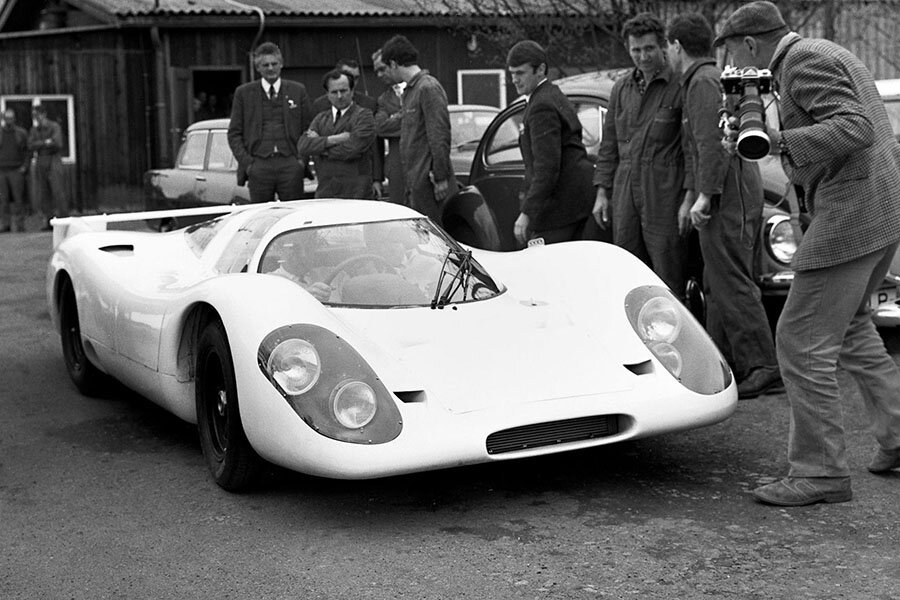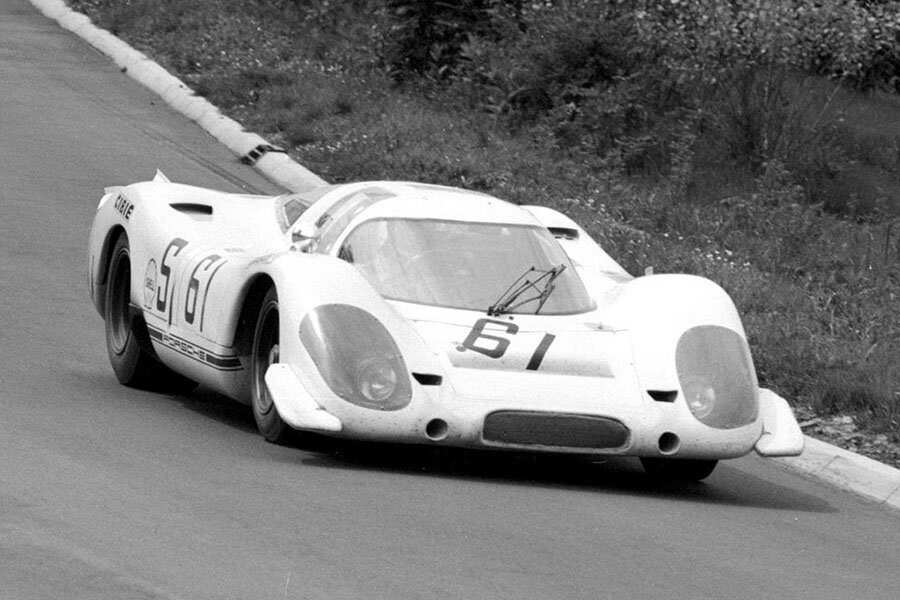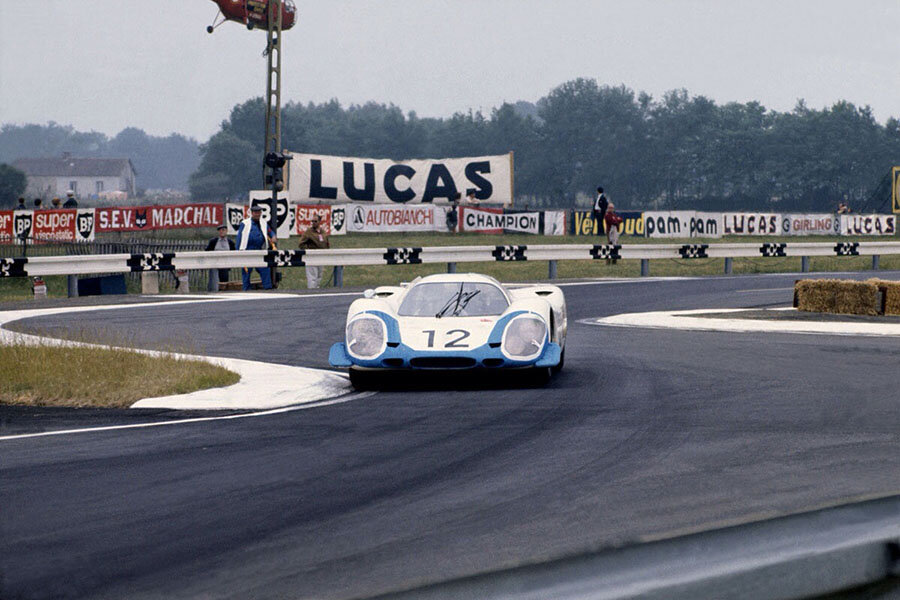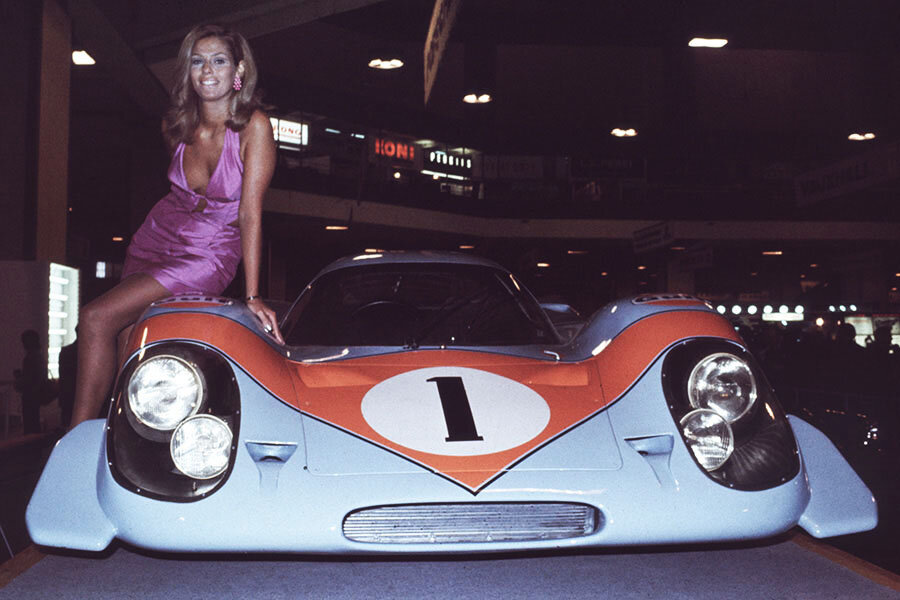Guide: Porsche 917 / 69
Background
One day after the 1967 Le Mans 24 Hours had seen all previous records broken, the FIA announced a three-litre engine limit would be imposed on Group 6 Prototypes from 1968 in an attempt to reduce speeds.
The existing five-litre class for Group 4 Sports cars would remain unchanged and required 50 cars for homologation.
Considering the three-litre Prototype rule to blatantly favour Porsche, Enzo Ferrari was incensed. He withdrew his team from the 1968 World Sportscar Championship to go Can-Am racing instead.
The opening rounds of the 1968 season saw Porsche battling with Alfa Romeo and Alpine in the three-litre Group 6 class. Meanwhile, the Group 4 category was faltering; the only opposition to John Wyer’s Gulf-backed Ford GT40s were some ageing Ferrari 250 LMs and the odd privateer Lola T70 GT.
Realising that crowds and sponsors wanted to see more big-engined Sports cars, in April 1968, the FIA decided to try and stimulate entries into the Group 4 category. They announced the 50-car homologation requirement would be slashed to just 25 units for 1969.
Back in Stuttgart, several weeks of deliberation followed over which class to pursue.
In July 1968, the decision was made: despite having only just finished the new three-litre 908 Group 6 Prototype, Porsche would begin to develop a new five-litre car for the Group 4 Sports category.
The resultant 917 was essentially a five-litre Prototype. By building 25 of the things, Porsche planned to gain a massive advantage over the rest of the field.
Chassis
The 917 was assembled around a complex and super lightweight aluminium-tubed spaceframe that combined elements of the 908 and 909 Bergspyder.
Weighing just 42kg, it was suitably reinforced to handle the prodigious levels of horsepower that were forecast.
The chassis was constructed of a new aluminium alloy that took almost a year to perfect welding techniques on. The tubular framework was also used to pipe oil to the front radiator. It was permanently gas-pressurised to detect any cracks in the welded structure.
In typical Porsche fashion, the 917 used a relatively short wheelbase of 2300mm.
Independent coil sprung double wishbone suspension was fully adjustable. Bilstein dampers were installed along with front anti-dive geometry.
Exotic alloys were used extensively: the hubs, springs, gear lever and steering column were titanium while the wheels and uprights were magnesium.
Ventilated disc brakes and ATE calipers were fitted at each corner along with centre-lock five spoke wheels originally shod with custom Dunlop tyres.
Of 15-inch diameter, the wheels initially measured 9-inches wide at the front and 12-inches wide at the rear.
Engine & Gearbox
For the 917, Hans Mezger created Porsche’s first twelve cylinder engine: it was an air-cooled 4.5-litre 180° Flat 12 that was given type number 912/00.
Effectively a combination of two Porsche 2.25-litre Flat 6 engines, the 912/00 motor featured a crankshaft divided in the middle that rested on plain bearings with titanium connecting rods.
At the centre of the engine, a train of gears drove four camshafts operating two valves per cylinder and the vertical shaft for a large horizontally-mounted air-cooling fan.
Mezger’s engine comprised a magnesium alloy block and light alloy head. It displaced 4494cc thanks to a bore and stroke of 85mm and 66mm respectively.
The reason Porsche did not go for a full five-litre motor at this stage was two-fold: they didn’t think the extra capacity would be necessary to win and, to save time, things like the bore, stroke, valve and port sizes of the 908 had simply been carried over.
Mechanical Bosch fuel-injection was employed and there were two separate ignition distributors feeding the 24 spark plugs.
With compression set at 10.5:1, the new engine initially produced a peak output of 520bhp at 8000rpm and 333lb-ft at 6500rpm.
The longitudinally mounted all-synchromesh gearbox was designed to take four or five gears. Transmission was through a triple-plate clutch and limited-slip differential.
Bodywork
Glassfibre body panels were glued to the tubular frame and, although the 917 was conceived primarily as a long tailed Coupe, the lift-up rear clamshell could be interchanged with a short tail section. However, this early Kurzheck was something of an afterthought and was never properly wind-tunnel tested.
Winglets were soon added to each front corner while, at the rear, moveable tail flaps reacted to the suspension and either created lift or downforce according to what was required.
In typical Porsche fashion, the 917 was handsome and clinical. It came with everything required for road use to include a full complement of lighting and a spare wheel mounted above the gearbox.
Interior
As per the regulations, the cockpit was notionally suitable for two people on account of the tiny, untrimmed and uninviting seat mounted to the left of the driver.
The 917 cabin was mounted well forward in the chassis to accommodate the huge Flat 12 engine. Additionally, the driver was forced to sit at an almost 45° angle with his feet hung out over the front axle.
Aside from a little padding on the driver’s seat, there was no upholstery, no sound deadening and no creature comforts.
One nice touch though was a traditional birch wood gear knob.
The main instruments were displayed in a simple crackle black dash.
All 917s were right-hand drive with a right-hand gearchange.
Weight / Performance
The completed car weighed in at 895kg. The class minimum was 800kg.
0-62mph required less than three seconds and the long tailed version had a top speed in the region of 220mph.
Launch
With no mention of the 917 at Porsche’s Hockenheim press day in January 1969, it came as a complete surprise when the new car was unveiled at the Geneva Motor Show on March 12th 1969. A price of DM 140,000 was quoted which equated to £14,500 or $35,000 at period exchange rates.
Porsche applied for homologation on 20th March 2969 when the FIA inspectors were shown half a dozen completed cars plus parts for the rest.
However, the governing body wanted to see 25 finished cars.
As the racing team was already flat out, Porsche were forced to draft in all kinds of administrative staff to help with assembly.
1969 Le Mans Test
Although not yet homologated, the 917 was permitted to run at the annual Le Mans Test weekend on March 29th and 30th.
A long tail was on hand for Rolf Stommelen (chassis 002) along with a short tail that Stommelen shared with Hans Herrmann (003). Both cars were painted plain white. The short tail was taken along purely for a shakedown.
Predicted to be the fastest car ever raced at Le Mans, the 917 still only had limited test mileage under its belt.
The car immediately proved to be very unstable and difficult to control.
Both drivers found it extremely hard to balance the 917 in corners and on the brakes. Down the high speed straights, they had their hands full just to stay on the road.
Stommelen hit 220mph on the Mulsanne Straight in the long tail car. This was 20mph faster than a Porsche had ever gone, but the Langheck body section was found to generate significant lift.
Like previous Porsche prototypes (all of which had vastly less power), the 917 had been designed for low drag rather than high downforce.
Despite these issues, Stommelen topped the time sheets and went over three seconds faster than Johnny Servoz-Gavin’s Matra MS630/650 (a new three-litre Group 6 Prototype).
Stommelen was also five seconds quicker than Paul Hawkins whose Lola T70 Mk3B GT was another five-litre Group 4 Sports car as per the 917.
Homologation Approval
Three weeks later (on April 20th 1969), 25 fully assembled 917s were displayed in front of the Porsche factory for inspection.
Unbeknown to the FIA, many of these ‘secretary-built’ cars could have their engines started and first gear engaged, but could drive no more than a few metres.
The 917s were lined up in such a way that most could be manoeuvred forwards but not actually driven out.
Homologation was granted and became effective from May 1st.
The majority of cars were then dismantled to be properly re-assembled at a later date as and when required.
1969 Spa 1000km
With the 917 approved for competition use, Porsche headed to Belgium for the Spa 1000km race on May 11th (round six of the 1969 World Sportscar Championship).
Daytona and Sebring had seen the Porsche 908s defeated, first by Roger Penske’s Sunoco-backed Lola T70 Mk3B GT and then by the Gulf-backed Ford GT40 of John Wyer’s team. However, since returning to Europe, the 908s had won at Brands Hatch, Monza and the Targa Florio.
With enough drivers for four cars, Porsche took a pair of 917s and four 908s to Spa.
The plain white 917s were those used at the Le Mans Test six weeks prior and, on this occasion, both wore short tail bodywork.
Jo Siffert and Brian Redman were entered in chassis 003 but, despite setting a practice time quick enough for pole, they elected to race one of the more predictable 908s instead.
917 chassis 002 was driven by Gerhard Mitter and Udo Schutz who qualified eighth.
Unfortunately, 002 had engine trouble from the off and Mitter crawled back around to the pits where the car was retired after just one lap.
Despite an inauspicious debut for the 917, Porsche’s blushes were saved by the 908 Langheck of Siffert / Redman which took victory ahead of the Pedro Rodriguez / David Piper Ferrari 312 P.
Long tailed 908s were also third and fourth. Porsche left Spa having extended their lead in the World Championship.
Afterwards, chassis 002 and 003 were both destroyed, the former in a long distance life test at the factory, the latter in a private testing crash.
1969 Nurburgring 1000km
Round six was the Nurburgring 1000km race on June 1st where, unsurprisingly, all Porsche’s factory drivers opted for the more sorted 908s.
Porsche desperately needed to promote the 917 so BMW drivers Hubert Hahne and Dieter Quester were asked to drive the new plain white short tail car (chassis 004).
A change of heart saw BMW withdraw their drivers during practice which gave Porsche the last minute headache of finding replacements.
At midnight after the first practice session, they hired David Piper and Frank Gardner, but neither were particularly happy in the ill-handling car.
Starting from tenth, they creditably finished eighth overall and second in the five-litre Sports class behind the IGFA Ford GT40 of sixth placed Helmut Kelleners and Reinhold Joest.
Porsche 908s filled the top five positions with Siffert / Redman once again taking outright victory. After the race, 917 chassis 004 returned to the factory and was not raced again until 1970.
1969 Le Mans 24 Hours
By this stage, Porsche had already overspent their 1969 racing budget and there was speculation the team might not appear at Le Mans.
The rumours about Le Mans turned out to be false, but Porsche had broken the bank so secret arrangements were being made to ensure the firm’s 1970 and 1971 racing programme would go ahead.
Held over June 14th and 15th, Le Mans was round eight of the World Sportscar Championship. Porsche elected to race three 908s and a pair of the fearsome 917s. All five cars were in long tailed configuration.
Two weeks prior, the Le Mans organisers had announced moveable aerodynamic devices would be outlawed for the race and big arguments ensued as Porsche claimed it would be unsafe to run the 917s without them.
Eventually, the 917s were allowed to race with operational flaps.
Aside from being the maiden competitive outing for the long tailed configuration, the 917s were little changed since Spa.
Two new cars were on hand. The pole starter was chassis 007 for Rolf Stommelen and Kurt Ahrens Jr. which hit 236mph down the Mulsanne Straight. This example had a 585bhp engine and a white livery with yellow nose.
Chassis 008 was allocated to Vic Elford and Richard Attwood. It started second and had a 560bhp engine, white paint and a blue nose.
Also present for the factory squad was a spare car driven in practice by Brian Redman, Herbert Linge and Rudi Lins. This car (chassis 006) was painted white with a red nose.
In addition to the works 917s, a brand new car, chassis 005, was delivered between practice and the race for English privateer John Woolfe. Woolfe had been the first customer to put his name down for a 917 at Geneva back in March.
Having arrived painted plain white, Woolfe’s signature blue and yellow stripes were added at the track where he was to drive with Digby Martland. However, after just two laps of practice, Martland struck a crash barrier coming onto the Mulsanne Straight and, although the damage was slight, he decided the car was too much of a handful and wisely told John Woolfe he didn’t want to drive it.
Porsche supplied Herbert Linge to co-drive for the race and Rolf Stommelen qualified the car ninth.
In this the final year of the traditional Le Mans start, both the works 917s made an excellent get away as did John Woolfe who had decided to do the opening stint himself.
Swept along by faster drivers, Woolfe lost control on the opening lap coming over the hump through the kink before Maison Blanche. Getting two wheels on the grass at over 150mph, 005 slid wide and Woolfe couldn’t catch it.
The 917 hit the guard rail, flipped onto its roof and continued down the road where it broke in two and caught fire. The track was completely blocked with burning wreckage.
Poor John Woolfe was thrown from the car and died in the helicopter as he was rushed to hospital.
As for the remaining pair of works 917s, the more powerful white and yellow Stommelen / Ahrens Jr. entry succumbed to an oil leak after 148 laps.
The white and blue Elford / Attwood machine retired with a broken gearbox in the 21st hour (after 327 laps).
A horrible weekend for Porsche culminated with the last 908 Langheck losing the race by a mere 120 metres to the Gulf-backed John Wyer Ford GT40 of Jacky Ickx and Jackie Oliver.
Chassis 005 was destroyed in John Woolfe’s fatal crash while chassis 006 and 008 were later scrapped after undergoing the long distance life test at the factory.
The only 1969 Le Mans entry to survive was chassis 007 (the pole starter) which was sold to the Gesipa Racing Team for 1970.
Ferrari Plans an Attack for 1970
After Le Mans, Ferrari announced they would be entering the five-litre Sports category for 1970.
Enzo Ferrari had received an influx of cash from selling a minority stake in his company to Fiat and was desperate to challenge Porsche.
1969 Watkins Glen 6 Hours
Having already won the 1969 World Sportscar Championship thanks to the 908, Porsche decided to officially withdraw their works cars for the rest of the season.
However, a pair of 908s were on hand for works drivers at round nine on July 12th: the Watkins Glen 6 Hours. They were factory owned cars entered by Ferdinand Piech’s mother’s Austrian import distributorship, Porsche Konstruktionen Salzburg.
Porsche scored a 1-2-3 headed by Siffert / Redman who once again demonstrated why they were considered the best endurance partnership in the sport.
1969 Zeltweg 1000km
Following the outing at Watkins Glen, the Porsche factory were unofficially out in force once again, this time for the season-ending 1000km race at the new Zeltweg circuit in Austria on August 10th.
Two brand new 917s were entered for potential customers David Piper (chassis 010) and Karl von Wendt (009).
Both cars would be piloted by factory drivers. The white von Wendt entry with its green wing flashes was allocated to Jo Siffert / Kurt Ahrens Jr. and the plain white Wrangler / Sandeman-backed Piper entry to Richard Attwood / Brian Redman.
The 917s appeared at Zeltweg in short tail trim. New equipment included 15-inch rear wheels and slightly heavier ventilated brakes. The anti-dive geometry was removed.
John Wyer’s Gulf-backed and now DFV-powered Group 6 Mirage M3 was on pole but received damage in a minor practice accident with Ahrens Jr. that ruled both cars out of any further participation in the session. The Siffert / Ahrens Jr. 917 would start fourth and Attwood / Redman sixth.
With Mirage, Matra and Alfa Romeo all out of the race around mid-distance, Siffert and Ahrens Jr. took the 917’s first win.
Attwood and Redman finished third behind the Jo Bonnier / Herbert Muller Lola T70 Mk3B GT of Scuderia Filipinetti.
Porsche’s Plans for 1970
Despite this happy ending, Porsche had already decided that, going forward, they wanted a partner organisation to race the 917 which would enable factory staff to focus fully on development.
Porsche turned to John Wyer Automotive Engineering (JWAE) whose Gulf Oil-backed operation were the undisputed masters of endurance racing.
Wyer would get the cars at no cost but, from the moment everything left Stuttgart, it was at JWAE’s expense.
Although a strategically sound move, money also played a part in the decision: Porsche had spent DM 30 million (£3.1m / $7.5m) on the combined 908 and 917 project in 1969.
However, Ferdinand Piech still wanted to race the 917s in 1970 and would campaign quasi works examples under the Porsche Konstruktionen Salzburg banner.
1969 Zeltweg Tests
Preparation for 1971 began when Wyer’s team arranged a test session at Zeltweg in early October.
Porsche took the Group 4 917 and a new Group 7 Spyder for the drivers to test.
With its upswept tail but otherwise identical chassis and engine, the Spyder proved to be around four seconds a lap quicker and much easier to handle.
Wyer’s men immediately set about modifying the Coupe’s rear end. They cut away the tail section and improvised a rudimentary upswept tail using aluminium sheets.
This immediately stabilised the Coupe and lap times began to drop quickly. The new short tail design was then perfected back in Germany and these modifications resulted in the revised 917 K for 1970.
To publicise the new partnership between Porsche and JWAE, a Gulf-liveried long tail was displayed at the London Motor Show later in October.
1969 Japanese GP
By this time, English privateer, David Piper, had taken delivery of his 917.
Piper had the car (chassis 010) flown out to the Far East for the Japanese GP at Fuji on October 10th. It was painted plain white and run under a Taki Racing Team entry. Piper was joined in the car by factory driver, Jo Siffert.
Some 170,000 spectators packed the 6km Fuji circuit which attracted a trio of works Nissan R382s complete with 6.2-litre V12 engines. Also on hand were a quintet of Toyota Gr.7 cars, all with five-litre V8s.
Qualifying saw the three big Nissans go quickest followed by a trio of Toyotas. Piper’s short tailed Porsche lined up seventh.
A good start by Siffert saw the 917 jump to second off the line but its chances were ruined by severe tyre trouble and oil leaking onto the windscreen.
Siffert and Piper eventually finished sixth.
Victory went to the Nissan R382 of Motoharu Kurosawa / Yoshikazu Sunako with the sister car of Moto Kitano / Tatsu Yokoyama second.
1969 Hockenheim 300 miles
Just over a week later, Piper’s 917 was back in Germany for the non championship Hockenheim 300 mile race on October 19th.
With the circuit plagued by fog for the entire weekend, the organisers decided to hold a pair of 50 lap races on the short and very narrow stadium section where visibility was better.
The drivers were given five laps practice but the plain white short tailed 917 was not at home on such a twisty layout.
Piper eventually finished third behind the Scuderia Filipinetti Lola T70 Mk3B GT of Jo Bonnier and the winning Gesipa Racing Team Porsche 908/02 of Jurgen Neuhaus.
1969 Kyalami 9 Hours
The final act of 1969 came at the Kyalami 9 Hour race on November 8th where David Piper was joined by factory driver, Richard Attwood.
Entered under the Team Perfect Circle banner with backing from Coca-Cola and Sandeman, the otherwise plain white 917 had received some modifications to the tail in an effort to improve its high speed handling.
By this time, the adjustable aero flaps had disappeared altogether.
After cracking the crankcase in practice, the splits were re-welded but the engine was not expected to last more than a few hours.
Somehow, the thing stayed together.
Piper / Attwood took the 917s second international victory despite being handed a two lap penalty after Attwood exceeded the 2.5 hour driver rule by seven minutes.
The win was Piper’s sixth in this event and, for 1970, his car was rebuilt back at the factory to the latest 917 K specification.
Text copyright: Supercar Nostalgia
Photo copyright: Supercar Nostalgia & Porsche - https://www.porsche.com












































